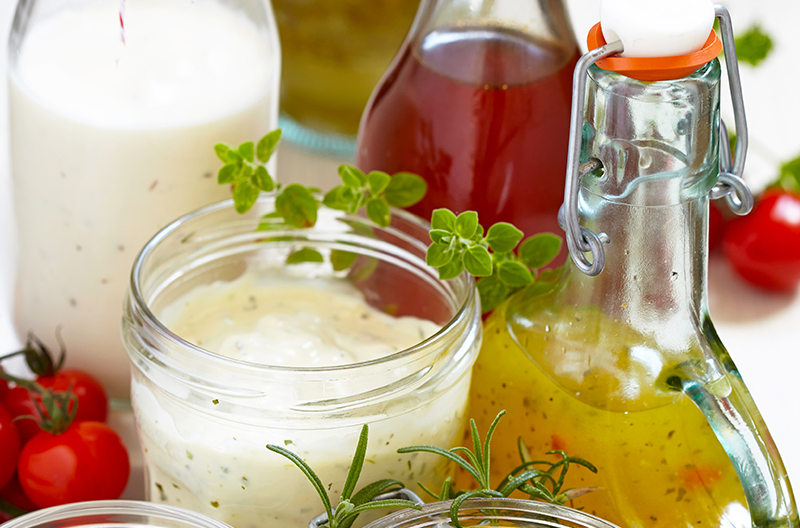If you tell people you’re passionate about nutrition, health, and fitness, it might conjure up images of a diet of nothing but salad, kale shakes, and quinoa. Salad may be one of the best ways to sate your hunger with fantastic plant foods and improve nutrient intake, but it doesn’t need to be a plain food. Making salad feel substantial is key – there is no point in eating salad on your lunch break if you’re going to end up stuffing your face with chocolate bars an hour later.
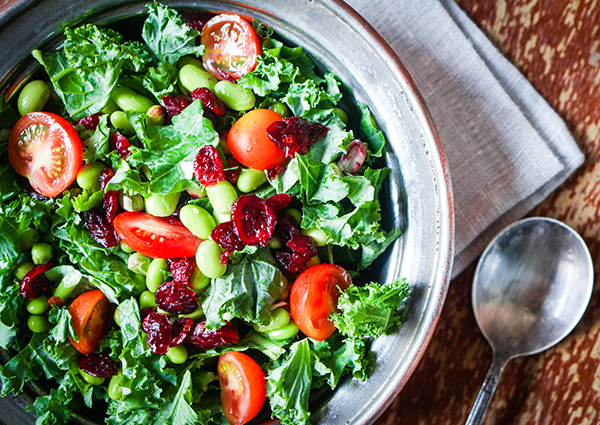 So, what makes a salad substantial and delicious?
So, what makes a salad substantial and delicious?
It’s essential to put together a great mix of flavors, textures, and a fantastic dressing. However, if you are trying to eat more salads for good health, you might be undoing the benefits by using store-bought dressings. Keep reading to learn about the dangers of store-bought dressing and how to make your own (much healthier) versions at home.
What’s Wrong with Store-Bought Dressings?
Many of the dressings you find on grocery store shelves are packed with artificial flavors, colors, and sodium-rich preservatives. They may contain full-fat cheese, added sugars such as high fructose corn syrup (HCFs), and unhealthy trans fats. This is true for both shelf-stable bottles or refrigerated versions of dressings, although the refrigerated salad dressings to tend to have fewer preservatives.
But how bad can it really be?
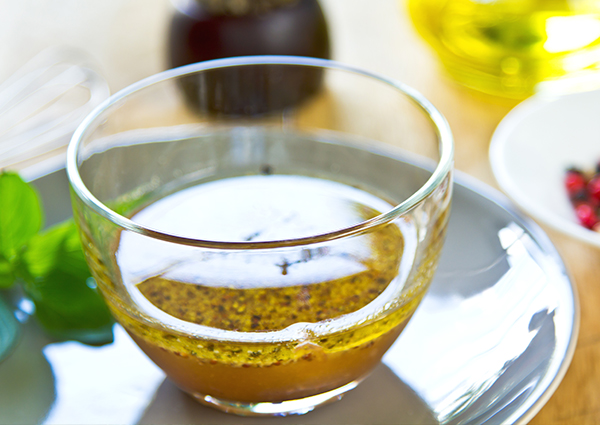
The standard serving size for salad dressings is 2 tablespoons. This may contain huge amounts of unhealthy ingredients and is often high in saturated fat, sodium, and sugar. Poor-quality saturated fats can increase the risk of heart complications, while sodium contributes to high blood pressure. Added sugar is associated with diabetes and obesity. Store-bought dressings can contribute to all of these problems, turning that healthy salad into a real health problem and ruining your diet.
For example, one serving of Marie’s Cesar Dressing has 3.5g of saturated fat per serving, Olive Garden’s signature Italian dressing contains 520mg of sodium per serving, and Ken’s ‘Light Options’ Honey Dijon dressing still managed to pack in a whole 7 grams of sugar.
Serving Sizes and Food Labels: What Can You Do?
The problems with store-bought dressings are even greater considering the disparity between the recommended serving and how much an average American will use on their salad. Many of us will use more than a single serving when it comes to eating our salads, and perceptions of a single serving vary wildly. The calories, added sugar, sodium and saturated fat can add up rapidly, especially if you’re snacking as well as eating salads.
Too much saturated fat will drive up “bad” LDL cholesterol and can lead to a dangerous build-up of vascular plaques in the arteries. A diet too high in sodium can increase your risk of heart attack and stroke, as well as potentially negating the beneficial effects of medications that treat high blood pressure. Flooding the body with added sugars in processed foods can spike your blood sugar, making you hungrier later and contributing to diabetes and metabolic syndrome, thus increasing your weight and bodyfat.
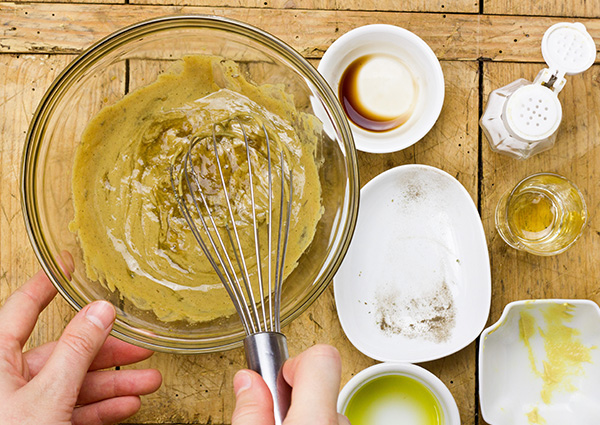
When you’re looking to avoid the pitfalls of store-bought dressings, you should start by reading food labels to check the calorie and macronutrient content of your dressing. A healthy dressing should contain no more than 120 calories, less than 200mg sodium per serving, little sugar (less than 2g per serving), and less than a gram of saturated fats. Be sure to invest a little time in your health and consider the health effects of certain dressings before you buy.
An even better choice is to make your own dressings at home. If you’re not looking to put in a lot of effort, you can simply use a drizzle of olive oil or balsamic vinegar, a squeeze of fresh lemon or lime juice, or even use a sprinkle of herb – the addition of some chopped garlic as an alternative to store-bought dressings and adds great health benefits.
We’ve included a list of 5 great recipes for healthier dressings so that you can enjoy your salads and get the best health benefits from them. Use these dressings to add flavor to your salads while also making them more substantial and avoiding the health-harming ingredients in their commercial counter-parts.
Greek Yogurt Ranch Dressing
Ranch is one of the United States’ most common and well-loved dressings, so you might be loathe to cut it out of your diet. This recipe provides a healthier alternative and gives you control over your diet, while being as flavorful as its industrial counterpart. It is always better to use fresh ingredients, but you can also use dried or powdered variations if you’re struggling to get your hands on fresh produce or need to cut costs.
Ingredients
- 3/4 cup whole milk plain Greek yogurt
- 1 clove garlic, finely minced OR 1 tsp garlic powder
- 1/4 cup fresh minced parsley OR 1 tsp dried parsley
- 1/4 medium onion, diced (about 2 tbsp.) OR 2 tsp onion powder
- 2 tbsp. fresh minced chives OR 1 tbsp. dried chives
- 1 tsp salt
- 1/4 tsp black pepper
- 2 tsp Dijon mustard
- Juice of 1/2 lemon (about 2 tbsp.)
- 1/4 cup-1/2 cup buttermilk
Instructions
- Combine all ingredients in a jar with a tight-fitting lid, shake until well combined.
- Alternatively, you can combine all ingredients in a food processor or blender and pulse until well combined and smooth.
- Refrigerate and let flavors blend for at least 30minutes, preferably 2 hours, before serving.
Store in an airtight bottle or jar in the fridge for up to a week. If you’re looking to make a thicker ranch dip, only use 1/4 cup of buttermilk. For a thinner dressing to drizzle on salad, add more buttermilk.
Calories per serving (2 tbsp.): 31
Chile-Lime Salad Dressing
This dressing is bright, mildly spicy, and has an amazing citrus undertone. If you want to add a bit more of a kick, add more red pepper flakes to taste. Homemade chile-lime dressing is great for taco salads, marinating shrimp or chicken, and bean salads.
Ingredients
- Zest and juice of 2 limes (about 4 tbsp. juice and 3 tbsp. zest)
- 1/4 cup red wine vinegar
- 1 tbsp. soy sauce
- 1 tbsp. honey
- 1/3 cup extra virgin olive oil
- 1 clove garlic, finely minced OR 1 tsp garlic powder
- 1/2 tsp red pepper flakes
- 1 tsp ground cumin
- 1/2 tsp salt
Instructions
- Combine all ingredients in a jar with a tight-fitting lid, shake until well combined.
- Refrigerate and let flavors blend for at least 30 minutes, preferably 2 hours, before serving.
If you use a low sodium soy sauce, be sure to check the flavor at every step to ensure the balance is correct. You can swap out the olive oil for any other mild-flavored plant-derived oil (such as argan or avocado).
Calories per serving (2 tbsp.): 96
Italian Salad Dressing
This Italian salad dressing is not as sweet as many you would find on a store shelf. Rather, it is packed with herbs and has a distinctive, nutty flavor. It goes especially well on side salads (particularly served alongside lasagna!) and antipasto salads. This is a versatile dressing and can be used for dipping breads or marinating poultry or fish.
Ingredients
- 2/3 cup extra virgin olive oil
- 1/4 cup red wine vinegar
- 3 tbsp. finely grated parmesan
- 1 tbsp. fresh minced parsley OR 1 tsp dried parsley
- 1/4 medium onion, diced (about 2 tbsp.) OR 2 tsp onion powder
- Juice of 1/2 lemon (about 2 tbsp.)
- 1 tbsp. fresh minced basil OR 2 tbsp. dried basil
- 1 tbsp. fresh minced oregano OR 2 tbsp. dried oregano
- 1 clove garlic, finely minced OR 1 tsp garlic powder
- 1 tsp honey
- 1 tsp salt
- 1/4 tsp black pepper
Instructions
- Combine all ingredients in a jar with a tight-fitting lid, shake until well combined.
- Alternatively, you can combine all ingredients in a food processor or blender and pulse until well combined and smooth.
- Refrigerate and let flavors blend for at least 30 minutes, preferably 2 hours, before serving.
You can swap out the olive oil for any other mild-flavored plant-derived oil.
Calories per serving (2 tbsp.): 186
Sesame-Ginger Salad Dressing
The bold flavors of ginger and sesame can take some people a little while to get used to – definitely an acquired taste! It might take a couple of salads before you fully appreciate the flavor of this next salad dressing. Packed full of tangy earthiness that comes from these Asian flavor combinations, this dressing can also be used as a marinade for chicken drumsticks or used with meat in the pressure cooker.
Ingredients
- 1/3 cup extra virgin olive oil
- 2 tbsp. toasted sesame oil
- 1/4 cup seasoned rice vinegar
- 1 clove garlic, finely minced OR 1 tsp garlic powder
- 2 tbsp. soy sauce
- 1 tbsp. honey
- 2 tbsp. peel and grated fresh ginger OR 2 tsp ground ginger
Instructions
- Combine all ingredients in a jar with a tight-fitting lid, shake until well combined.
- Refrigerate and let flavors blend for at least 30 minutes, but preferably 2 hours, before serving.
Between the seasoned rice vinegar and the soy sauce, this dressing should have plenty of salt, so it is unnecessary to add extra. If you feel the need to season further, try apple cider vinegar and low-sodium soy sauce. As with previous recipes, you can swap out the olive oil for any other mild-flavored plant oil.
Calories per serving (2 tbsp.): 123
Balsamic Vinaigrette Salad Dressing
Finally, we have a recipe for balsamic vinaigrette dressing. This is one of the simplest, tastiest recipes on the list and will be an instant classic for anyone with a taste for fine cooking. We highly recommend using a good balsamic vinegar – not all vinegars are created equal. You’ll really notice the difference in your dressing if you spend a few extra cents on the good stuff, and it spreads well across the many servings you can get from a good balsamic. This dressing can be used for all salads, drizzling on fresh tomatoes or watermelon (no, really!), or marinating meats.
Ingredients
- 1/2 cup extra virgin olive oil
- 1/3 cup balsamic vinegar
- 1 tsp Dijon mustard
- 1 clove garlic, finely minced OR tsp garlic powder
- 1 tbsp. honey
- 1 tsp salt
- 1/4 tsp black pepper
Instructions
- Combine all ingredients in a jar with a tight-fitting lid, shake until well combined.
- Refrigerate and let flavors blend for at least 30 minutes, preferably 2 hours, before serving.
Add a pinch of cinnamon to make this dressing more suitable for salads with fruit. Examples of this could be on mango crayfish salad or Waldorf salad, but whatever you put it on it will provide a rich, distinctive kick.
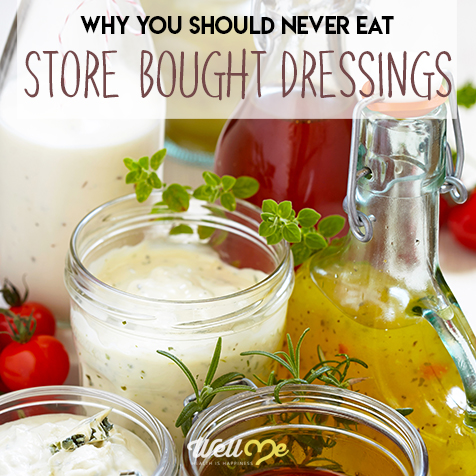
If you’re looking to invest in your health for the long-term, and want to make salads that are both delicious and nutritious, you need a good dressing. We’ve provided you with five different dressings, each with its own health benefits and amazing flavor combinations. Store-bought dressings can be a serious health risk, but these homemade dressings focus on fresh and healthy ingredients to boost the health benefits of salad. Try even one of these dressings and you’ll be hooked on creative, delicious salads – one of the healthiest cravings!

